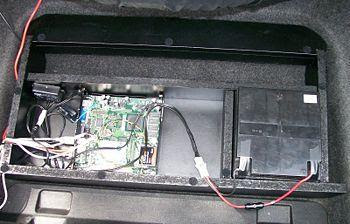This hack illustrates how a car can be controlled from anywhere in the world by tapping into the disgnostic systems and onboard webserver of the car. The objective is to keep the car “live” and connected to the Internet 24×7 even when not being driven. It should run continuously without flattening the car battery by critically selecting a low-power computer. Also, the user should be able to start the engine, pop the trunk, lock/unlock, and view all vehicle diagnostics from his iPhone. The chosen car was a Mazda RX-8 as shown in the image below. It was released in 2004 and consists of 6-speed manual transmission with a 1.3L 13B-MSP RENESIS engine.
The computer used in this hack is an Alix-1 which draws very little power but is fast enough to run a full Linux distribution system. To fit into a recess in the base of the RX-8 boot, a mounting frame was assembled. It has room to mount the Alix-1, a USB hub, a charge circuit, and a deep-cycle 28A/h sealed lead acid battery. The SLA battery is charged using an intelligent battery charger so it can continuously run the Alix-1. Whenever the car is running, the charger tops it up. The charger works perfectly in this application although it was designed for topping up deep-cycle batteries. Shown in the image below is the Alix-1 mounted in a custom subframe inside the boot of RX-8.
To run diagnostics on the engine management system, a laptop is usually plugged by a mechanic to the On-Board Diagnostics (OBD) port under the dash. The Alix-1 is permanently connected to the port on this RX-8 and dozens of parameters about vehicle performance including speed, RPM, intake manifold temperature, engine load, fuel level, fuel pressure, fuel injection mode, timing and many other items are polled to the ECU every few seconds. A MySQL database is used to store all data indefinitely. Shown in the photo below in a conference where the integration of the Alix-1 with the existing electronics was explained.
To be able to access the car for remote diagnostics, it should be continuously connected to the Internet. The Alix-1 is allowed to have software control of engine start/stop, accessory power, door lock/unlock, and boot release by building a custom ignition manager based on an Arduino development board. Through Wi-Fi, it allows authorized laptops to associate with it to access vehicle management functions directly since the car acts as a mobile access point.
The GPS values were stored using a USB GPS receiver that allows the data logging system. It has every set of engine management parameters which can be used to match engine events to locations, generate tracks showing previous journeys, or display direction information. The back right window of the car has a mounted RFID reader which unlocks the car and starts the engine automatically when it detects an authorized FRID tag. The RFID implant being used to unlock the front door of the house is demonstrated in the video below.
A password-protected web interface optimized for full-screen display on an iPod Touch or iPhone running the SOPODS full screen web browser is provided by the webserver of the car. The 3 screens of the web nterface include Control, Telemetry, and Location. The web interface accessed from an iPod Touch is briefly demonstrated in the video below. A more professional version was created on the next video.
For the audio system, the Alix-1 is allowed to inject audio directly into it by modifying the BOSE head unit shown in the below image. The head unit was opened up and soldered input leads to the CD player circuit board since the BOSE sound system in the RX-8 has no “line in” connection. Connected through the head unit was the headphone output from the Alix-1. Any sound played by the Alix-1 is injected into the head unit when the CD is selected. Through the existing sound system, the Alix-1 can play music and issue voice alerts.



